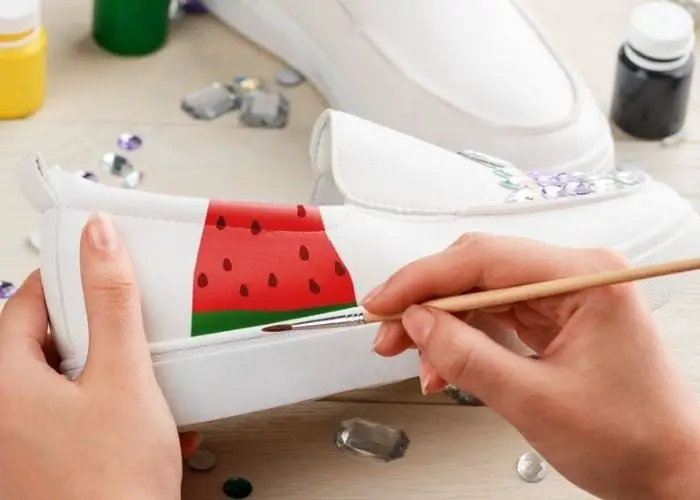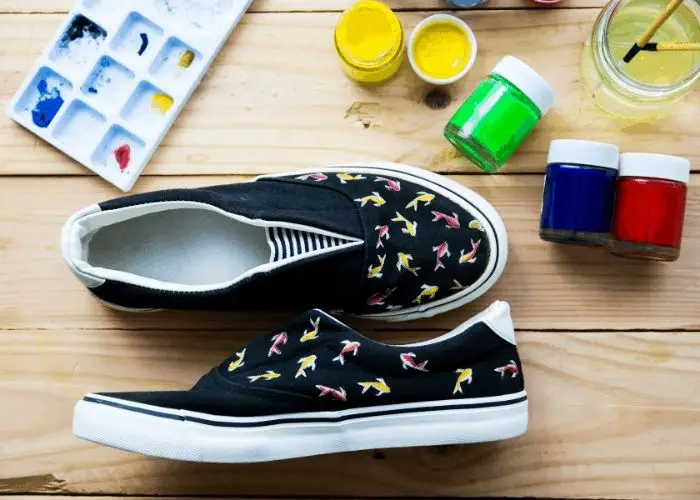Ever gazed at your plain shoes and dreamt of turning them into a canvas for art?
Here’s a surprising fact: 92% of customized shoes are painted using acrylic!
But, “Can I use acrylic paint on shoes?” you ask. From my years of experience in shoe artistry, I’ve seen many transform mundane footwear into stunning masterpieces using acrylic.
This article will dive deep into its feasibility and guide you on achieving lasting results.
We’ll address common concerns and give expert advice on the following;
- Can you paint shoes with acrylic paint?
- How to paint shoes with acrylic paint
- What kind of paint to use on shoes?
- How to keep acrylic paint on shoes
- Does acrylic paint wash off shoes?
Let’s dive right in;
Can you Use Acrylic Paint On Shoes?
Yes, you can use acrylic paint on shoes. Ensure the shoes are clean before applying. Acrylic adheres well to these materials. To preserve the design, apply a waterproof sealant after painting. This technique is favored for customizing and adding unique flair to shoes.
Can you paint Converse with acrylic paint?
Yes, you can paint Converse with acrylic paint.
Traditional cotton duck canvas Converse, known for its durability, pairs exceptionally well with acrylic, as the porous canvas absorbs the paint, ensuring vibrant designs.
For the lighter synthetic polyester Converse, while still paintable, the finish might differ slightly.
Regardless of material, always seal with a waterproof finish to enhance the artwork’s lifespan, ensuring vivid and lasting results on both shoe types.
Can you use acrylic paint on canvas shoes?
Yes, you can use acrylic paint on canvas shoes.
Canvas, known for its porous and absorbent nature, pairs exceptionally well with the water-based composition of acrylic paint.
Given the canvas’s capillarity, it permits optimum pigment penetration.
When acrylic, a polymer emulsion, is applied, it undergoes coalescence on the canvas, forming a resilient film.
How to paint canvas shoes with acrylic paint
Before we dive in, gather these supplies:
Supplies Needed:
- A pair of clean canvas shoes.
- Acrylic paints in your chosen colors.
- Paint brushes in various sizes (from detail brushes to wider ones).
- A cup of water for cleaning brushes.
- Paper towels or rags.
- Painter’s tape (to keep areas clean, like the soles).
- A palette or plate to mix paints.
- Hairdryer (optional, for quicker drying).
Step-by-Step Guide:
- Prep Your Shoes: Remove the laces from your canvas shoes. Clean any dirt or dust off the shoes with a damp cloth and let them dry thoroughly.
- Mask Off Areas: Use the painter’s tape to cover any areas you don’t want to paint, such as the rubber soles.
- Plan Your Design: Before diving in with the paint, it might help to sketch out your design on paper. This will serve as a handy guide!
- Begin Painting: Dip your brush into the paint and start with broader strokes for larger areas, then switch to a smaller brush for details. Remember, it’s always easier to add more paint later, so start with light layers and build up.
- Dry Between Layers: Allow each paint layer to dry completely before adding another one. If you’re impatient like me, you can use a hairdryer to speed up the process. But ensure it’s on a cool setting!
- Final Touches: After you’ve painted your design and everything is dry, you can remove the painter’s tape. Check for any areas that might need touch-ups.
Can you use regular acrylic paint on shoes?
Yes, you can use regular acrylic paint on fabric and canvas shoes, but not directly if you intend to wear them.
You can’t just slap on the acrylic and go; you need to turn it into fabric paint first.
How?
Mix 2 parts of your regular acrylic paint with 1 part fabric medium. This combo ensures the paint stays flexible and long-lasting on the shoe.
However, if you’re thinking about leather or vinyl shoes, this method won’t work as effectively.
And a quick heads-up: don’t use vinegar as a shortcut – it’s not a substitute for the fabric medium.

Can you use acrylic paint on fabric shoes?
Yes, acrylic paint can be applied to fabric shoes. Fabric’s absorbent nature synergizes with acrylic’s water-based composition, allowing for rich color adherence.
However, to ensure flexibility and prevent cracking, it’s beneficial to mix acrylic paint with a fabric medium.
This combination ensures a vibrant design that endures wear and tear.
Can you use acrylic paint on sneakers?
Yes, Acrylic paint is often used on sneakers because of its versatility and durable nature.
Sneakers, whether canvas or leather, have surfaces that can hold acrylic paint’s pigments effectively.
Acrylic, being water-based, adheres well, and when dried, it forms a flexible, resilient layer.
How to paint sneakers with acrylic paint
Ready to elevate your kicks with a touch of artistry? Acrylics can be a sneakerhead’s best friend when customizing.
Materials to Gather:
- Your chosen sneakers (prime real estate for creativity).
- High-quality acrylic paints designed for flexibility.
- Assorted brushes – from filberts for broad strokes to precision liners for details.
- A clean sponge or cloth.
- Mild detergent.
- Painter’s tape (to mask off pristine zones).
- Palette or mixing tray.
- Acrylic finisher to seal and protect.
Sneaker-Painting Process:
- Preparation is Key: Begin by un-lacing your sneakers. Using a mixture of mild detergent and water, gently clean your sneakers, focusing on the areas you intend to paint.
- Mask Like a Pro: With the painter’s tape, shield any parts you wish to remain untouched — this often includes logos, soles, and certain trims.
- Lay Down a Base: If you’re altering the sneaker’s primary color or need a neutral ground for your design, apply a thin base coat. This ensures subsequent layers pop.
- Flex those Artistic Muscles: Dive into painting. Start broad, refine later. Think of it as laying the midsole before adding those detailed overlays.
- Details Make the Difference: Utilize your liner brushes to get into the sneaker’s nooks and intricacies. Whether it’s accentuating the vamp, highlighting the counter, or adding flair to the quarter, precision is paramount.
- Seal the acrylic painted shoes: Once your design has thoroughly dried, apply an acrylic finisher. This acts like a topcoat, ensuring longevity and vibrancy, and protecting against creasing.

Can you use acrylic paint on vans?
Yes, you can use acrylic paint on Vans shoes.
Vans, typically crafted from woven cotton or linen fibers, provide a suitable surface for acrylic’s adherence.
The reason for painting vans with acrylic is twofold: firstly, the porous nature of canvas ensures excellent absorption of acrylic’s water-based composition, allowing for vibrant color application.
Secondly, the flexible properties of acrylic complement the dynamic movement of Vans during regular wear, ensuring the artwork remains intact and vibrant over time.
Is acrylic paint good for shoes?
Yes, acrylic paint is beneficial for shoes due to several reasons. It offers a wide spectrum of vibrant colors, allowing for diverse artistic expressions.
Acrylic adheres effectively to various shoe materials, especially canvas, ensuring a durable design.
Its quick-drying nature ensures efficiency in customizing, while its water-resistant properties help in guarding against minor splashes.
Furthermore, its flexibility complements the natural movement of shoes, reducing the risk of cracking or peeling.
As we mentioned before, different types of shoes will require different painting techniques.
Let’s have a look at different types of shoes and if you can use acrylic paint on them.
Acrylic painting for shoes
| Shoe Material | Recommended Paint | Alternative Method |
|---|---|---|
| Leather | Angelus Leather Paint | – |
| Denim | Fabric Paint | 1:2 mix of Angelus 2 Soft Fabric Medium with acrylic paint |
| Canvas | Fabric Paint | 1:2 mix of Angelus 2 Soft Fabric Medium with acrylic paint |
| Fabric | Fabric Paint | 1:2 mix of Angelus 2 Soft Fabric Medium with acrylic paint |
| Vinyl | Angelus Leather Paint | – |
| Suede | Suede Dye or Angelus Suede Paint | – |
| Synthetic Leather | Angelus Leather Paint or Acrylic Paint | If using acrylic, prep with a proper primer first. |
Here is how to seal acrylic paint on leather shoes.
How to Prep Shoes for Acrylic Painting
No matter what type of shoes you are planning on painting, it is important to prep them before starting.
This will help the paint to adhere better and prevent any cracking or peeling.
- To prep your shoes, start by giving them a good cleaning with a soft cloth.
- You can also use a mild soap and water solution if your shoes are particularly dirty.
- Once they are clean, allow them to dry completely before starting to paint.
- If you are painting leather shoes, you may also want to apply a thin layer of primer before painting. This will help the paint adhere better and prevent cracking or peeling.
How to Paint Shoes With Acrylic Paint – Any type

Now that you have prepared your shoes, you are ready to start painting! Follow these simple steps to get started:
Materials and tools needed:
- Acrylic paint (here are the best acrylic paint for shoes that I recommend)
- Paintbrush
- Water
- Paper towel
Step One: Begin by sketching your design on a piece of paper.
This will help you to plan out your design and ensure that everything is in the right place before you start painting.
If you make a mistake, simply erase it and try again.
Step two: Clean your surface.
As we mentioned before, it is important to clean your shoes before painting them.
This will help the paint to adhere better and prevent any cracking or peeling.
You can use a soft cloth and a mild soap and water solution to clean your shoes.
Once they are clean, allow them to dry completely before starting to paint.
Step three: Apply a base coat
Begin by applying a thin layer of paint to your shoes. You can use a brush or sponge to apply the paint evenly.
Work in small sections so that the paint does not dry before you have a chance to spread it out.
Once you have applied a thin layer of paint, allow it to dry completely before moving on to the next step.
Step four: Apply the main coat
After the base coat has dried, you can begin to apply the main color of paint to your shoes.
Again, be sure to work in small sections and use a brush or sponge to spread the paint evenly.
Allow the main coat to dry completely before moving on to the next step.
Step five: Add your design
Now it’s time to add your design! Begin by sketching out your design on a piece of paper.
Once you have planned out your design, you can begin painting it onto your shoes.
Use thin layers of paint so that the shoes can still flex and move without cracking.
Allow each layer of paint to dry completely before adding another.
Step six: Seal your acrylic painted shoes
Once you are happy with your design, you can seal it with a clear coat of acrylic varnish.
This will help to protect your design and prevent the paint from chipping or peeling. Allow the varnish to dry completely before wearing your shoes.
Read also: how to get acrylic paint off of concrete.
What kind of paint do you use on shoes?
The best paint to use when painting shoes is acrylic paint. Acrylic paint is a versatile and durable type of paint that can be used on a variety of surfaces.
It is also relatively easy to work with, making it a good choice for beginners.
Canvas shoes, leather shoes, and vinyl shoes are all good options for painting with acrylics. Other good paints are fabric paint, spray paint, and leather paint.
1. Acrylic Paint
Acrylic paint is the best choice for painting shoes because it is versatile.
You can use acrylic paints to create various designs on your shoes. Luckily, you can learn how to get acrylic paint off shoes in an easy process.
Acrylic paint also dries very quickly, so you won’t have to wait long for your shoes to dry before you can wear them.
Overall, acrylic paint is an excellent choice for painting shoes because it is easy to use and provides great results.
2. Paint for fabric shoes
Fabric paints are a type of paint that is specifically designed for use on fabric.
It is made from pigments that are suspended in a binder that helps the color adhere to the fabric.
Fabric paint can be used on a variety of fabrics, including cotton, linen, and polyester.
It is also relatively easy to work with, making it a good choice for beginners.
Light fabric shoes, vinyl or leather shoes are all good options for painting with fabric paint.
3. Leather paint
Leather paint is a special type of paint that is designed to be used on leather.
It is available in a variety of colors and can be used to change the color or appearance of leather shoes, belts, purses, and other accessories.
Leather paint can be applied with a brush, and it dries quickly. It is also water-resistant, so it will not chip or peel off.
Leather paint is a great way to revive old leather shoes or to give new ones a unique look.
Note – All these three paints: leather paint, acrylic paints, and fabric paints, are good choices for painting shoes.
They are both relatively easy to work with and can be used on a variety of surfaces. It’s you to choose between acrylic or fabric paint.
Paints That are Not Recommended For Shoes
Some types of paint are not recommended for use on shoes. These include oil-based paints and watercolor paints.
Oil-based paints are not a good choice for painting shoes because they can be difficult to work with and can take a long time to dry.
Watercolor paints are also not a good choice for painting shoes because they are not as durable as other types of paint.
Is Acrylic Paint on Shoes Waterproof?
Yes, but there are a few caveats. Acrylic paint is water-based, so it will usually bead up and roll off of waterproof materials like rubber or plastic.
However, if the surface of the shoe is porous, the paint can soak in and become difficult to remove.
Once the paint dries, it will be water-resistant, but it won’t be completely waterproof.
To make sure your painted shoes can withstand wet weather, you’ll need to apply a top coat for acrylic paint.
Does acrylic paint wash off shoes?
Yes, acrylic paint will not stay and eventually wash off shoes if not properly sealed.
While acrylics are water-based and initially easy to clean off surfaces, they become more resistant over time.
However, on shoes exposed to various conditions like water, mud, or wear, unsealed acrylic paint may chip or fade.
How to make acrylic paint stay on shoes?
To keep acrylic paint on shoes pristine and protected, a sealant is essential. Without it, the paint can easily get damaged or stained.
The best way to seal paint on shoes is to use a clear matte sealant. This type of sealant will protect the paint without changing the appearance of the shoes.
To apply the sealant, simply brush it onto the surface of the shoes. Once the sealant is dry, you can wear your shoes as usual.
If you are worried about getting the sealant on your clothes, you can put your shoes in a washing machine bag before putting them in the machine.
This will prevent any stray sealant from damaging your clothes.
Interesting read: What can you use acrylic paint on?
How to Prevent Acrylic Paint from Cracking on Shoes
Once you have painted and sealed your shoes, you’ll want to take some steps to prevent the paint from cracking.
Because if not properly sealed, acrylic paint can crack and peel over time.
To prevent acrylic paint from cracking on shoes, it’s important to seal the paint with a clear topcoat before wearing the shoes.
You can also add a layer of primer before painting to help the paint adhere better to the surface.
If you’re concerned about the paint cracking, you can also try using flexible acrylics instead.
These are designed to resist cracking and peeling, making them ideal for painting shoes.
Read also: Can you put polyurethane over acrylic paint?
FAQs
Will acrylic paint ruin shoes?
The short answer is maybe. It all depends on the type of shoe, the paint, and how it is applied. Acrylic paint is a kind of plastic, and when it dries, it forms a harder plastic film. This can be good or bad for shoes. If you have a pair of leather shoes that you want to add some color to, then painting them with acrylic paints can actually help to protect the leather. However, if you have a pair of fabric shoes, then the paint can make them stiff and uncomfortable to wear. So, it really all depends on the situation.
Can you use acrylic paint on Nike shoes?
The simple answer is yes. You can use acrylic paints on just about any type of shoe, including Nike shoes. In fact, acrylic paint is a great choice for painting shoes because it is very durable and long-lasting. It can also be easily applied to shoes using a brush or sponge, and it dries quickly. However, before you start painting your Nike shoes, there are a few things you need to do to prepare them. First, make sure the shoes are clean and free of any dirt or debris. Next, roughen up the surface of the shoes with sandpaper so that the paint will have something to grip onto. Once you’ve prepped the shoes, you’re ready to start painting!
Will regular acrylic paint work on leather?
The short answer is yes, you can use regular acrylic paint on leather. The slightly longer answer is that it might not be the best idea. Acrylic paint is designed to adhere to various surfaces, including wood, metal, and glass. However, leather is a bit more difficult to work with. It’s important to remember that leather is a natural material, and it will absorb the paint differently than other materials. Read more on using acrylic paint on leather.
Can you paint shoes with acrylic paint summary?
Acrylic paint is a versatile medium that can be used on a variety of surfaces, including shoes.
However, it’s important to keep in mind that each type of shoe will respond differently to the paint.
Leather and fabric shoes will absorb acrylic paint differently, and you may need to take special precautions when prepping and painting them.
But with a little bit of care and attention, you can use acrylic paint to create a unique and stylish pair of shoes that will last for years to come.
Thanks for reading! We hope this article was helpful. If you have any questions or comments, please feel free to leave them below.











Leave a Reply